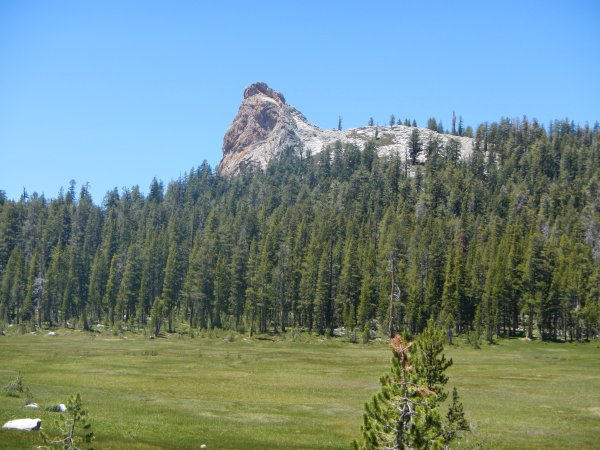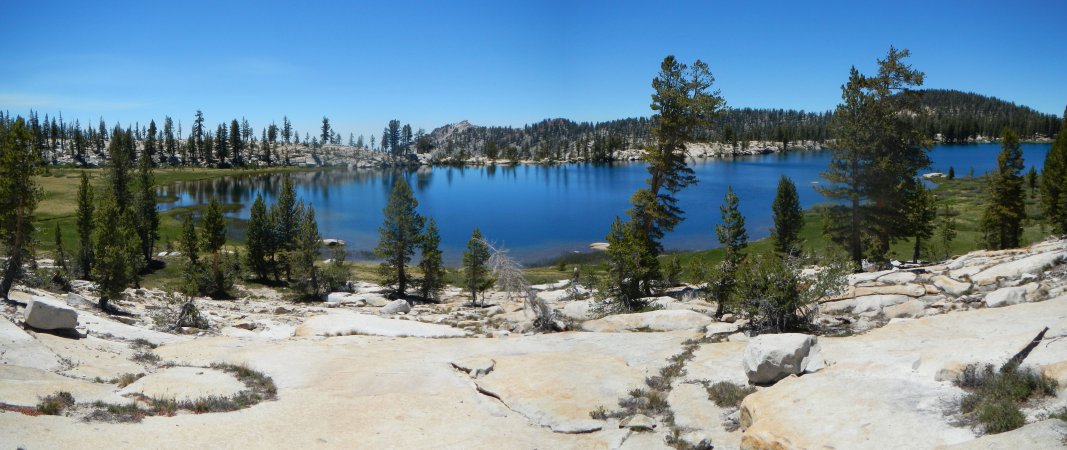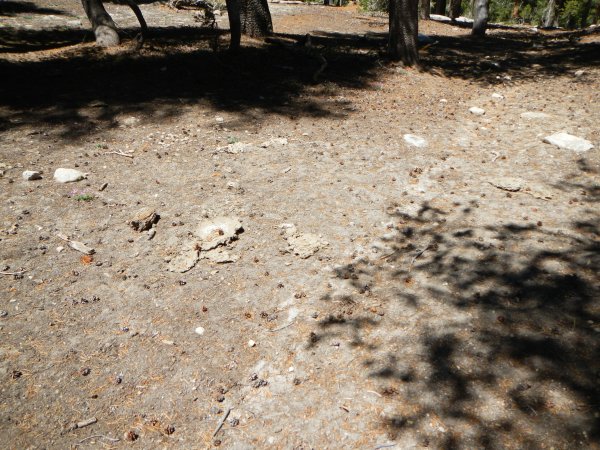Woodchuck Country
20-23 June 2012
by Bill Finch
I planned a very ambitious hike which would have taken me to Goddard Creek and Blue Canyon, but it was not to be. By mid-afternoon a severely irritated spot had developed in my crotchal area. Even the application of special lotions barely helped. But, I get ahead of myself. Having picked up a wilderness permit the day before, I was able to arrive at the Rancheria Trailhead reasonably early. It was a beautiful day and I was curious to find how the low snow winter had affected things.
Day 1
The area was pretty dry but plenty of wildflowers lined the trail. I took a break at the turnoff to the Crown Basin trail then continued past Hoffman Mountain and its impressive point known as Finger Rock.

Finger Rock is a prominent landmark above Round Corral Meadow.
I left the Rancheria Creek drainage and crossed into the Woodchuck Creek Drainage. The extensive meadows in Woodchuck Country were coveted by cattlemen who drove in their herds to graze them. Remnants of an old log structure are found next to the trail at Lacy Camp.

There is not much left of this old log cabin above the meadow of Lacy Camp.
After dropping further into the canyon, I developed the irritation that I referred to earlier. I knew I would have to bail out at the first reasonable campsite and decided that I would try to make Chimney Lake. After turning off toward the lake late that afternoon, I noticed a different flower out of the corner of my eye. It turned out to be a rare
Fritillaria pinetorum, also known as Pinewoods Missionbells or Davidson's Fritillary.

There are very few sightings in Fresno County of this rare flower also known as Pinewoods Missionbells or Davidson's Fritillary.
Since it was the longest day of the year, I had plenty of time to find a nice spot and set up camp.

Chimney Lake is a popular camp spot in Woodchuck Country.
I slept well that night, despite a solo serenade from a frog that staked out territory in the shallows near my tent.
Day 2
The next morning, my injury felt much better but I decided to take it easy anyway. In the morning, I revisited the fritillery and took photos of many other flowers along the trail. By mid-afternoon, I decided to visit nearby Marsh Lake.

Surrounded at its inlet by grass, Marsh Lake is appropriately named.
There are several nice campsites nearby, and unlike Chimney Lake, campfires are a possibility due to its lower elevation.
Day 3
The next morning I headed cross country up to Woodchuck Lake. The day before, I had hiked a little of the route to see if it was feasible and it was as easy as expected. Most of the route was onslabs of granite, with an occasional duck here or there showing that I wasn't the first to take the path.

The cross country route from Chimney and Marsh Lakes to Woodchuck Lake was a pleasant walk in the park.
I enjoyed lunch at the lake and watched a party of four arrive at a nice campsite at the west end of the lake. After a short visit with them, I found the trail and proceded toward Crown Lake. There were many fine views of Woodchuck Lake along the way.

Woodchuck Lake is very popular and this photo shows why.
Soon, I was walking across the relatively flat country leading to a lovely view of Crown Lake.

Smoke from a fire filled the Middle Fork Kings Canyon to the south, but there was relatively clear view of Crown Lake and beyond.
I settled in a well used area at the north end of Crown Lake and slept well except for the slow leak in my Thermarest Neo. (I repaired a pinhole leak in the Neo upon my return home, and it performed beautifully for the final three trips of the summer.)
Day 4
Frost covered the meadow as I headed south parallel to Scepter Creek and toward Chuck Pass.

I really didn't expect to see frost at this elevation.
In addition to granitic rocks and scattered prebatholitic metamorphics, Woodchuck Country is home to volcanic rocks. I spotted an outcrop that I thought might answer a question I had posed the day before, "Are the volcanic rocks pre- or post-glacial in age?" Sure enough, I found a granitic glacial erratic perched on glacially grooved volcanic rock.

This granitic erratic sits on glaically grooved volcanic rock. Note Kettle Dome down canyon. Smoke from nearby fires had mostly cleared from the day before.
Shortly after completing the geologic study, I took the turnoff the Chuck Pass. At the pass there was ample evidence that cattle are still grazing the meadows of Woodchuck Country. Dried cow manure littered the trail.

Both cow and horse manure were abundant at Chuck Pass, suggesting cattle had been driven through the area.
Not long after dropping down from the pass, Indian Springs appeared. One of the springs supports lush greenery.

This unusually lovely place is just one of the many Indian Springs.
After lunching at the spring, I headed cross country toward the Woodchuck/Rancheria divide. The path sure beat dropping all the way down to Lacy Camp then climbing up the steep trail to the divide. Heading toward the trailhead, I kept a sharp eye open for spotted coral root orchid which I had seen along the trail in previous years. My vigilance was rewarded, but not with the coral root. Instead I found
Pleuricospora fimbriolata or fringed pinesap.

Fringed pinesap looks somewhat like a white snow plant at first glance, but more resembles white asparagus.
Another report for an earlier trip to Woodchuck Country can be found
here.

21 May 2012
revised 29 October 2012
One Page Version 7 January 2013













